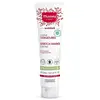What's inside
What's inside
 Key Ingredients
Key Ingredients

 Benefits
Benefits

 Concerns
Concerns

 Ingredients Side-by-side
Ingredients Side-by-side

Water
Skin ConditioningCoco-Caprylate/Caprate
EmollientDicaprylyl Carbonate
EmollientGlycerin
HumectantButyrospermum Parkii Butter
Skin ConditioningC10-18 Triglycerides
EmollientCandelilla/Jojoba/Rice Bran Polyglyceryl-3 Esters
EmulsifyingGlyceryl Stearate
EmollientCetearyl Alcohol
EmollientSodium Stearoyl Lactylate
Emulsifying1,2-Hexanediol
Skin ConditioningPersea Gratissima Oil
Skin ConditioningPolyacrylate Crosspolymer-6
Emulsion StabilisingTocopherol
AntioxidantCaprylyl Glycol
EmollientSodium Stearoyl Glutamate
CleansingPropanediol
SolventCitric Acid
BufferingHydrolyzed Avocado Protein
Skin ConditioningMaltodextrin
AbsorbentPentylene Glycol
Skin ConditioningSodium Hydroxide
BufferingHamamelis Virginiana Leaf Extract
Skin ConditioningXanthan Gum
EmulsifyingPassiflora Edulis Fruit Extract
Skin ConditioningWater, Coco-Caprylate/Caprate, Dicaprylyl Carbonate, Glycerin, Butyrospermum Parkii Butter, C10-18 Triglycerides, Candelilla/Jojoba/Rice Bran Polyglyceryl-3 Esters, Glyceryl Stearate, Cetearyl Alcohol, Sodium Stearoyl Lactylate, 1,2-Hexanediol, Persea Gratissima Oil, Polyacrylate Crosspolymer-6, Tocopherol, Caprylyl Glycol, Sodium Stearoyl Glutamate, Propanediol, Citric Acid, Hydrolyzed Avocado Protein, Maltodextrin, Pentylene Glycol, Sodium Hydroxide, Hamamelis Virginiana Leaf Extract, Xanthan Gum, Passiflora Edulis Fruit Extract
Ingredients Explained
These ingredients are found in both products.
Ingredients higher up in an ingredient list are typically present in a larger amount.
Citric Acid is an alpha hydroxy acid (AHA) naturally found in citrus fruits like oranges, lemons, and limes.
Like other AHAs, citric acid can exfoliate skin by breaking down the bonds that hold dead skin cells together. This helps reveal smoother and brighter skin underneath.
However, this exfoliating effect only happens at high concentrations (20%) which can be hard to find in cosmetic products.
Due to this, citric acid is usually included in small amounts as a pH adjuster. This helps keep products slightly more acidic and compatible with skin's natural pH.
In skincare formulas, citric acid can:
While it can provide some skin benefits, research shows lactic acid and glycolic acid are generally more effective and less irritating exfoliants.
Most citric acid used in skincare today is made by fermenting sugars (usually from molasses). This synthetic version is identical to the natural citrus form but easier to stabilize and use in formulations.
Read more about some other popular AHA's here:
Learn more about Citric AcidDicaprylyl Carbonate comes from carbonic acid and caprylyl alcohol, a fatty alcohol. It is an emollient and gives skin a velvet feel. The sources of Dicaprylyl Carbonate may be synthetic or from animals.
As an emollient, Dicaprylyl Carbonate creates a film on the skin. This film traps moisture in, keeping your skin soft and hydrated.
Tocopherol (also known as Vitamin E) is a common antioxidant used to help protect the skin from free-radicals and strengthen the skin barrier. It's also fat soluble - this means our skin is great at absorbing it.
Vitamin E also helps keep your natural skin lipids healthy. Your lipid skin barrier naturally consists of lipids, ceramides, and fatty acids. Vitamin E offers extra protection for your skin’s lipid barrier, keeping your skin healthy and nourished.
Another benefit is a bit of UV protection. Vitamin E helps reduce the damage caused by UVB rays. (It should not replace your sunscreen). Combining it with Vitamin C can decrease sunburned cells and hyperpigmentation after UV exposure.
You might have noticed Vitamin E + C often paired together. This is because it is great at stabilizing Vitamin C. Using the two together helps increase the effectiveness of both ingredients.
There are often claims that Vitamin E can reduce/prevent scarring, but these claims haven't been confirmed by scientific research.
Learn more about Tocopherol